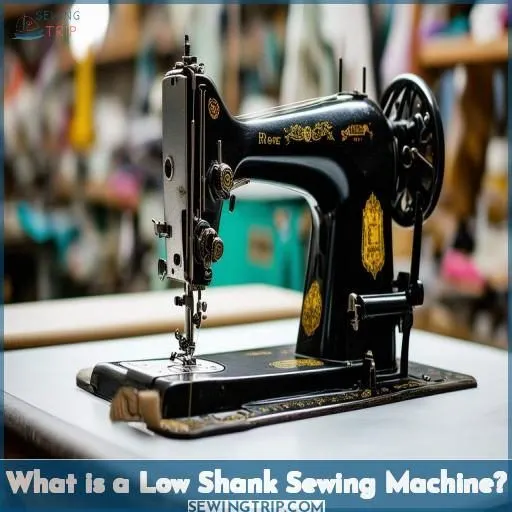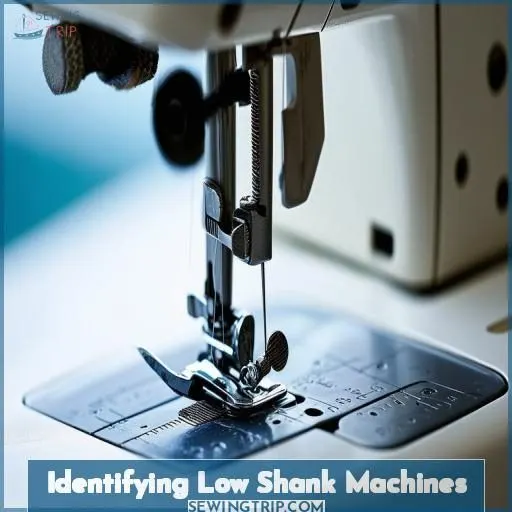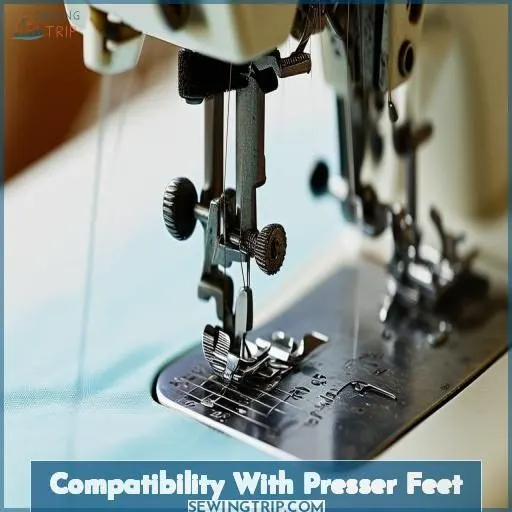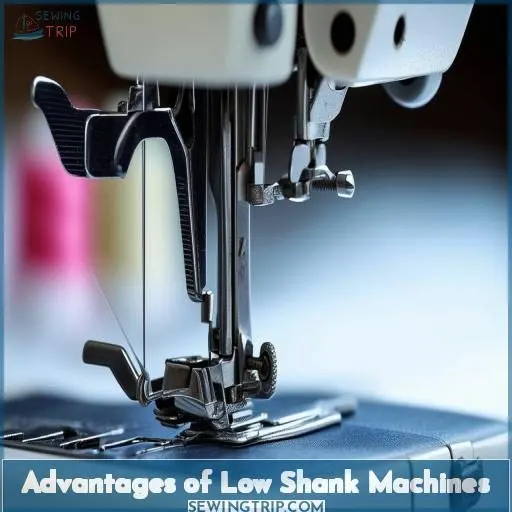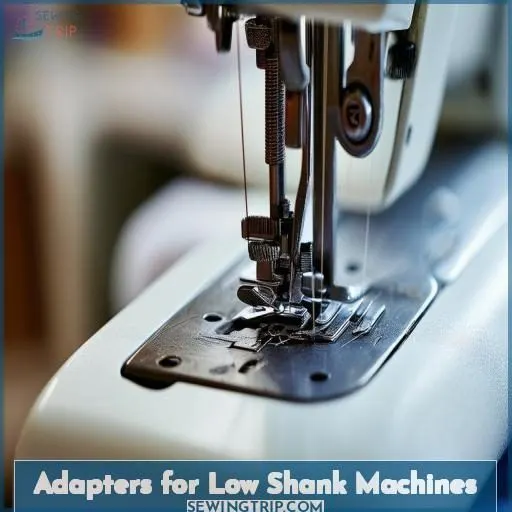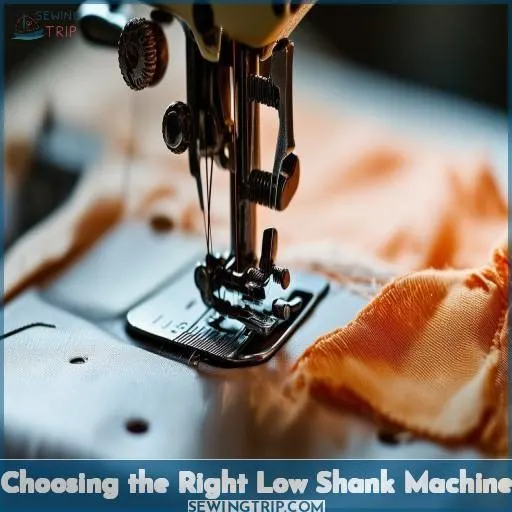This site is supported by our readers. We may earn a commission, at no cost to you, if you purchase through links.
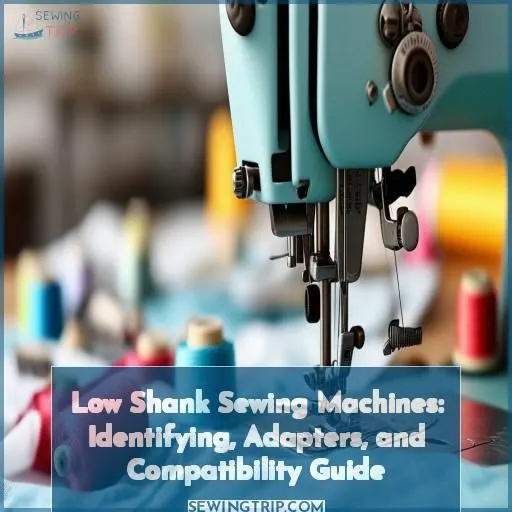
These machines sport a 0.75" (or shorter) distance between the presser foot base and thumbscrew, allowing easy snap-on foot changes.
While screw-on options offer more variety, snap-ons are beginner-friendly.
Identify a low shank by measuring or checking the brand; many popular household names like Singer utilize this style.
Low shanks are budget-conscious yet versatile, suiting quilting, garments, and more.
Adapters further expand your presser foot options—perfect for maximizing your machine’s full potential.
Table Of Contents
Key Takeaways
- A low shank sewing machine is like your trusty sidekick – compact, beginner-friendly, and ready to tackle all sorts of home projects with its versatile presser foot system. Think of it as the "Swiss Army Knife" of sewing machines!
- Measuring that shank height is a must. Anything under 3/4 inch from the presser foot base to the screw center, and you’ve got yourself a low shank machine – the perfect apartment-friendly companion for taming fabric.
- Don’t let the small stature fool you – with the right adapters and presser feet, your low shank machine can take on even the trickiest tasks. It’s like giving your sewing bestie a secret superpower!
- These budget-conscious workhorses are a dream for novice sewists or casual hobbyists. They’re the gateway to unleashing your creativity without breaking the bank. Who knows, your low shank machine might just become your new partner in crime for all things fabric!
What is a Low Shank Sewing Machine?
A low shank sewing machine is identified by the height of the metal rod, called the shank, that connects the presser foot to the machine. It measures 3/4 inch or less from the presser foot base to the center of the thumb screw.
To determine if your machine is low shank, simply lower the presser foot and measure this distance precisely.
Definition of a Low Shank Machine
You’ve got a low shank sewing machine if the distance from the presser foot’s base to the center of its thumb screw is:
- 0.75 inches or less
- Usually around 0.5 inches
- The standard for most home machines
Low shanks are ideal for sewing common fabrics like:
- Quilting cottons
- Linens
- Lightweight canvas
Their compact size suits typical home sewing projects perfectly.
Measuring Low Shank Height
Low shank height allows seamless sewing on most fabrics. To measure:
- Lower presser foot fully
- Measure distance from foot base to screw center
- If ≤ 3/4" (0.75"), it’s a low shank machine
This easy measuring method guarantees proper presser foot compatibility. While low shanks handle quilting cottons and lighter materials effortlessly, high shank machines offer advantages for sewing wadding or multiple fabric layers.
Identifying Low Shank Machines
To identify if you have a low shank sewing machine, check the following:
- Measure the distance from the presser foot’s base to the center of the thumb screw attaching it.
- If it’s 3/4 inch or less, you have a low shank machine—the standard for most home sewing projects.
- Scrutinize the presser foot attachment system. Low shanks typically use snap-on or screw-on feet.
- Consider the machine’s brand and model. Household names like Singer, Brother, and Janome commonly manufacture low shank machines.
While high shanks handle thick fabrics better, you’ll find low shanks perfectly capable for quilting cottons, linens, and lightweight canvases. And with the right low shank adapter or presser feet, even tricky tasks are achievable on these versatile workhorses.
Compatibility With Presser Feet
You’ve figured out your machine is a low shank model – great! Now let’s talk about presser foot compatibility. Low shank machines are designed to work seamlessly with snap-on presser feet, which simply snap into place. They can also use screw-on feet with a screwdriver, giving you flexibility. However, you may need a low shank adapter to use some universal snap-on presser feet. Here are a few key points to keep in mind:
- Snap-on feet are the easiest to use on low shank machines
- Screw-on feet require a screwdriver but offer more options
- A low shank adapter expands your presser foot selection
- Consider the tasks you’ll be doing when choosing presser feet
With the right presser feet, your low shank machine can tackle an impressive variety of sewing projects!
Advantages of Low Shank Machines
So now that we’ve covered compatibility with presser feet, let’s explore the advantages of low shank machines. They’re widely available, making them an accessible option for most sewists. Additionally, their affordability appeals to budget-conscious crafters and beginners. Here are three key benefits:
- Versatility for home projects
- User-friendly for novice sewists
- Cost-effective for casual hobbyists
Low shank machines strike the perfect balance of capability and value. Their popularity stems from their ability to handle common fabrics like cottons, linens, and lightweight synthetics seamlessly. You’ll find these workhorses in many sewing rooms, ready to tackle diverse projects with ease.
Adapters for Low Shank Machines
While low shank machines are versatile, you may want to use specialized presser feet not included with your machine. No worries! You can:
- Get a low shank snap-on adapter to use universal snap-on presser feet
- Find adapters for specific presser foot styles to use screw-on feet
- Check if your machine brand offers proprietary adapters
With the right adapter, all kinds of presser feet are at your fingertips – from quilting feet to zipper feet. Expand your sewing options and let your creativity soar! Just be sure the adapter matches your machine’s low shank and presser foot type. With a little research, you’ll be stitching like a pro in no time.
Choosing the Right Low Shank Machine
When choosing a low shank sewing machine, it’s essential to verify its shank height by measuring from the presser foot base to the screw center – low shanks are typically 3/4" or less. Additionally, consider whether you need a snap-on or screw-on presser foot system, and if adapters are required for compatibility with specialty presser feet.
Shank Height Measurement
First, measure the shank height—from the presser foot base to the screw center. If it’s 3/4" or less, you’ve got a low shank. Low shanks are perfect for everyday fabrics but struggle with thick materials. While adapters let you convert shank types, measuring accurately prevents compatibility issues.
Snap-On vs Screw-On
When choosing a low shank machine, you’ll need to decide between snap-on or screw-on presser feet. Snap-on feet offer:
- Ease of use
- No tools required
- Compatibility with most low shank machines
However, screw-on feet provide greater versatility, allowing snap-on and screw-on foot conversion with the right adapters. Consider your sewing needs and machine’s compatibility for the most suitable presser foot system.
Adapter Requirements
When choosing a low shank machine, you’ll need to examine adapter requirements if you want to use specialty presser feet. Snap-on adapters allow you to use universal snap-on feet on low shank, screw-on machines. Some low shank adapters convert screw-on feet for use on snap-on models. Adapter availability varies by brand, so check compatibility guides before purchasing.
Frequently Asked Questions (FAQs)
What is a low shank sewing machine?
A low shank sewing machine is your trusty sidekick for taming fabric, featuring an apartment-friendly presser foot height under 3/4 inch. Master everyday sewing projects with this versatile, compact crewmate.
How do you tell if your sewing machine is high or low shank?
To determine if your machine is high or low shank, lower the presser foot and measure the distance from its base to the screw’s center. If it’s under 1", it’s a low shank; over 1", it’s a high shank. It’s an easy way to identify your machine’s capabilities.
Is Singer a low shank machine?
You’ve hit the nail on the head – Singer sewing machines are typically low-shank models, designed for smooth operation with most fabric weights. The lower shank height provides ample space for guiding layers through with ease, making Singer an ideal choice for home sewists.
Are Brother sewing machines low or high shank?
Most Brother sewing machines are low shank, perfect for beginners and everyday sewing projects with lightweight fabrics. However, they offer some high shank models designed for heavy-duty tasks like upholstery or canvas work.
What types of fabrics require a low shank machine?
You’ll want a low shank machine for delicate, lightweight fabrics like silk, chiffon, or organza. These require a gentle touch and precise control that low shank models offer. Heavier materials demand the power of industrial high shank machines. Understanding fabric needs ensures perfect stitch quality every time.
How much throat space is common for low shank machines?
You’ll find most low shank machines have a throat space around 6-9 inches, offering ample room for maneuvering fabric while sewing. This compact design suits typical home sewing projects nicely.
Can low shank presser feet be used on high shank machines?
No, you can’t use low shank presser feet on high shank machines directly. The shank height difference means low shank feet won’t securely attach. However, you can use adapters designed to convert high shank machines for using low shank snap-on feet.
What maintenance is required for low shank sewing machines?
What’s the secret to keeping your machine running smoothly? Proper maintenance! Clean lint traps regularly, oil per manufacturer guidelines, and store your low shank sewing machine dust-free after each use. A well-cared-for machine is a happy, high-performing one.
Are low shank machines suitable for industrial/commercial use?
Low shank machines aren’t designed for the rigors of industrial or commercial sewing. Their lighter build prioritizes affordability and home use over heavy-duty tasks. For professional applications requiring extended operation and handling thicker materials, you’ll want a sturdy high shank machine.
Conclusion
Like a trusted companion, a low shank sewing machine‘s versatility and user-friendly design empower limitless creative possibilities. With precise shank height measurement, well-informed presser foot selection, and judicious use of adapters, you’ll maximize your machine’s full potential. Embrace the low shank’s beginner-friendly appeal without compromising versatility for quilting, garments, and beyond—an investment that grows with your skills.

